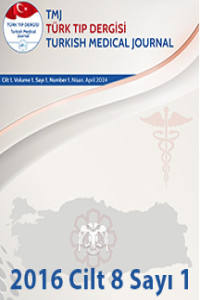Abstract
Amaç: Kontinyu spinal anestezi, spinal anestezi sağlamak amacıyla düşük dozlarda lokal anesteziğin subaraknoid aralığa, bir kateter yoluyla aralıklı olarak verilerek spinal anestezinin sürdürülmesi yöntemidir. Bu çalışmadaki amacımız, kontinyu spinal anestezi uygulanan kardiak olarak yüksek riskli 17 hastadaki deneyimlerimizi sunmaktır.
Materyal ve Metot: Otuz ile 100 yaşları arasında kardiak olarak yüksek riskli 17 hastaya sezaryen, kolon cerrahisi, prostatektomi, kalça protezi, femur fraktürü ve diz artroplasisi anestezi yöntemi için kontinyu spinal anestezi planlandı. Hastalara oturur pozisyonda aseptik şartlar sağlandıktan sonra L3-L4 veya L4-L5 intervertebral aralıktan spinal kateter takıldı. Daha sonra kateterden % 0.5’lik izobarik bupivaka-inden 1 mİ yapıldı. Operasyonun tipine göre, istenilen sensoryal blok seviyesine ulaşılıncaya kadar aynı konsantrasyonda lokal anestezikten 0.5 ml’lik dozlar halinde tekrarlandı. Kan basıncı, nabız ve sensoryal blok seviyesi kaydedildi.
Bulgular: Tüm hastalarda spinal kateterler başarıyla takıldı. Şiddetli hipotansiyon ve bradikardi atakları görülmedi. İki hastada hipotansiyon meydana geldi. Sensoryal blok seviyesi sezaryenda T7, kolon cerrahisinde T5, prostatektomide T6-T7, kalça protezi, femur fraktürü ve diz artroplastisnde T9-T11 ’e ulaştı Hastaların hiçbirinde intraoperatif olarak genel anesteziye geçilmedi. Postoperatif mortalite gözlemlenmedi.
Sonuç: Kontinyu spinal anestezi hemodinamik olarak stabil olmayan kardiak olarak yüksek riskli hastalarda güvenli bir anestezik teknik olduğunu düşünüyoruz.
Dr. Ayşenur DOSTBİL
Dr. Mine ÇELÎK
Dr. Hacı Ahmet ALICI
Dr. Ali Fuat ERDEM
Dr. İlker İNCE
Dr. Ali AHISKALIOĞLU
Dr. Mehmet CESUR
Dr. Mehmet AKSOY
References
- 1. De Andres J, Valia JC, Olivares A, Geliver J. Continuous spinal anesthesia: a comparative study of standard microcatheter and Spinocath. Reg Anesth Pain Med. 1999;24:110-6.
- 2. Favarel-Garrigues JF, Sztark F, Petit-jean ME, ThicoTpe M, Lassie P, Dabadie P Hemodynamic effects of spinal anesthesia in the elderly: single dose versus titration through a catheter. Anesth Analg. 1996 ;82:312-6.
- 3. Michaloudis D, Petrou A, Bakos P, Chat-zimichaliA, Kafkalaki K, Papaioannou A, Zeaki M, Flossos A. Continuous spinal anaesthesia/analgesia for the periope- rative management of high-risk patients. Eur J Anaesthesiol. 2000;17:239-47.
- 4. Hurley RJ, Lambert DH. Continuous spinal anesthesia with a microcatheter technique: preliminary experience. Anesth Analg. 1990;70:97-102.
- 5. Vijayan R, Chan L, Raveenthiran R Continuous spinal anaesthesia--early experience in University Hospital, Kuala Lumpur. Med J Malaysia. 1995;50:401-10.
- 6. Denny NM, Selander DE. Continuous spinal anaesthesia. Br J Anaesth 1998; 81:590-7.
- 7. Gurit S, Reinhard S, Möllmann M. Continuous spinal analgesia or opioid-added continuous epidural analgesia for postoperative pain control after hip replacement. Eur J Anaesthesiol 2004; 21: 708-14.
- 8. Van Gessel E, Foster A, Gamulin Z. A prospective study of feasibility of continuous spinal anesthesia in a university hospital. Anesth Analg 1995;80:880-5.
- 9. Klimscha W, Weinstabl C, Ihas W, et al. Continuous spinal-anesthesia with a microcatheter and low-dose bupiva-caine decreases the hemodynamic-effects of centroneuraxis blocks in elderly patients. Anesth Analgesia 1993; 77:275-80.
- 10. Möllmann M, Cord S, Hoist D, Aut der Landwehr U. Continuous spinal anaesthesia or continuous epidural anaesthesia for post-operative pain control after hip replacement? Eur J Anaesthesiol 1999; 16:454-61.
- 11. Paternoster DM, Pascoli I, Parotto M, et al. Pulmonary hypertensin during pregnancy: management of two cases. Arch Gynecol Obstet 2010;281:431-4.
- 12. Duggans AB, Katz SG. Combined spinal and epidural anesthesia for cesarean section in a parurient with severe primary pulmonary arterial hypertension? Anaesth Intensive Care 2003;31:565-9.
- 13. Gandhimathi K, Atkinon S, Gibson FM. Pulmonary hypertension complicating twin pregnancy:continuous spinal anaesthesia for caesarean section. Int J Obstet Anesth 2002;11:301-5.
- 14. Koçum A, Şener M, Çalışkan E, et al. Epidural anesthesia for cesarean section in a patient with severe mitral stenosis and pulmonary hypertension. J Cardiothorac Vase Anesth 2010;24: 1022-3.
- 15. Bedard E, Dimopoulus K, Gatzoulis MA. Has there been any progress made on pregnancy outcomes among women with pulmonary arterial hypertension? Eur Heart J 2009;30:256-65.
- 16. Dresner M, Pinder A. Anaesthesia for caesarean section in women with complex cardiac disease: 34 cases using the Braun Spinocath spinal catheter. Int J Obstet Anest 2009; 18:131-6.
- 17. Imbelloni LE, Gouveia MA, Cordeiro JA. Continuous spinal anesthesia versus combined spinal epidural block for major orthopedic surgery: prospective randomized study. Sao Paulo Med J. 2009; 127:7-11.
- 18. Möllmann M, Cord S, Holst D, Auf der Landwehr U. Continuous spinal anaesthesia or continuous epidural anaesthesia for post-operative pain control after hip replacement? Eur J Anaesthesiol 1999; 16:454-61.
- 19. Pitkânen M, Rosenberg P, Silvanto M, Tuominen M. Haemodynamic changes during spinal anaesthesia with slow continuous infusion or single dose of plain bupivacaine. Acta Anaesthesiol Scand. 1992;36:526-9.
- 20. Michaloudis D, Petrou A, Bakos P, et al. Continuous spinal anaesthesia/analge-sia for the perioperative management of high-risk patients. Eur J Anaesthesiol. 2000;17:239-47.
- 21. Mallon JS, Edelist G. Risk factors of im- portance the patient. Probl Anesth 1992;6:193-204.
- 22. Brooks-Brunn JA.Predictors of postoperative pulmonary complications following abdominal surgery. Chest. 1997; 111:564-71.
- 23. Askrog VF, Smith TC, Eckenhoff JE. Changes In Pulmonary Ventilation During Spinal Anesthesia. Surg Gynecol Obstet 1964;119:563-7.
- 24. Savas JF, Litwack R, Davis K, Miller TA. Regional anesthesia as an alternative to general anesthesia for abdominal surgery in patients with severe pulmonary impairment. Am J Surg. 2004 Nov;188: 603-5.
- 25. Brian JE Jr, Seifen AB, Clark RB, Robertson DM, Quirk JG. Aortic stenosis, cesarean delivery, and epidural anesthesia. J Clin Anesth 1993;5:154-7.
- 26. Shin YK, Jeffrey CK. Combined mitral and aortic stenosis in a parturient: epidural anesthesia for lobar and delivery. Anesth Analg 1993;76:665-86.
- 27. Collard CD, Eappen S, Lynch EP, Concepcion M. Continuous spinal anesthesia with invasive hemodynamic monitoring for surgical repair of the hip in two patients with severe aortic stenosis. Anesth Analg 1995;81:195-8.
Abstract
Objectives: Continuous spinal anesthesia is a method for maintaining spinal anesthesia with small doses of local anesthesia injected intermittently in the subarachnoid space through indwelling catheter. In this study our aim is to present our experiences in 17 patients with high cardiac risk who were performed continuous spinal anesthesia.
Materials and Methods: Seventeen patients aged 30 to 100 ages with high cardiac risk were scheduled for continuous spinal anesthesia for caesarean section, colon surgery, prostatectomy, hip replacement, femoral fracture treatment and knee arthroplasty. Following administration of subcutaneous anaesthesia in the sitting position under aseptic conditions, a spinal catheter was inserted through the intervertebral space between the L3-L4, L4-L5 vertebrae. Then, 1 ml 0.5% isobaric bupivacaine was injected through the catheter. According to the type of the operation, 0.5 ml 0.5% isobaric bupivacain was repeated until the desired level of sensory block was achieved. Blood pressure, pulse, sensory block level of patients were all recorded.
Results: Spinal catheters were inserted succesfully in all patients. None of the patients required sedation. Severe hypotension and bradycardia were not observed. Hypotension occured in 2 patients. Sensory block level raised to T7 in caesarean, toT5 in colon surgery, to T6-T7 in prostatectomy, to T9-T11 in hip replacement, femur fracture treatment and knee arthroplasty. None of the patients were not converted to general anesthesia intraoperatively. Postoperative mortality was not observed.
Conclusion: We think that continuous spinal anesthesia is a safe anesthetic technique for high-risk cardiac patients with unstable hemodynamic status.
References
- 1. De Andres J, Valia JC, Olivares A, Geliver J. Continuous spinal anesthesia: a comparative study of standard microcatheter and Spinocath. Reg Anesth Pain Med. 1999;24:110-6.
- 2. Favarel-Garrigues JF, Sztark F, Petit-jean ME, ThicoTpe M, Lassie P, Dabadie P Hemodynamic effects of spinal anesthesia in the elderly: single dose versus titration through a catheter. Anesth Analg. 1996 ;82:312-6.
- 3. Michaloudis D, Petrou A, Bakos P, Chat-zimichaliA, Kafkalaki K, Papaioannou A, Zeaki M, Flossos A. Continuous spinal anaesthesia/analgesia for the periope- rative management of high-risk patients. Eur J Anaesthesiol. 2000;17:239-47.
- 4. Hurley RJ, Lambert DH. Continuous spinal anesthesia with a microcatheter technique: preliminary experience. Anesth Analg. 1990;70:97-102.
- 5. Vijayan R, Chan L, Raveenthiran R Continuous spinal anaesthesia--early experience in University Hospital, Kuala Lumpur. Med J Malaysia. 1995;50:401-10.
- 6. Denny NM, Selander DE. Continuous spinal anaesthesia. Br J Anaesth 1998; 81:590-7.
- 7. Gurit S, Reinhard S, Möllmann M. Continuous spinal analgesia or opioid-added continuous epidural analgesia for postoperative pain control after hip replacement. Eur J Anaesthesiol 2004; 21: 708-14.
- 8. Van Gessel E, Foster A, Gamulin Z. A prospective study of feasibility of continuous spinal anesthesia in a university hospital. Anesth Analg 1995;80:880-5.
- 9. Klimscha W, Weinstabl C, Ihas W, et al. Continuous spinal-anesthesia with a microcatheter and low-dose bupiva-caine decreases the hemodynamic-effects of centroneuraxis blocks in elderly patients. Anesth Analgesia 1993; 77:275-80.
- 10. Möllmann M, Cord S, Hoist D, Aut der Landwehr U. Continuous spinal anaesthesia or continuous epidural anaesthesia for post-operative pain control after hip replacement? Eur J Anaesthesiol 1999; 16:454-61.
- 11. Paternoster DM, Pascoli I, Parotto M, et al. Pulmonary hypertensin during pregnancy: management of two cases. Arch Gynecol Obstet 2010;281:431-4.
- 12. Duggans AB, Katz SG. Combined spinal and epidural anesthesia for cesarean section in a parurient with severe primary pulmonary arterial hypertension? Anaesth Intensive Care 2003;31:565-9.
- 13. Gandhimathi K, Atkinon S, Gibson FM. Pulmonary hypertension complicating twin pregnancy:continuous spinal anaesthesia for caesarean section. Int J Obstet Anesth 2002;11:301-5.
- 14. Koçum A, Şener M, Çalışkan E, et al. Epidural anesthesia for cesarean section in a patient with severe mitral stenosis and pulmonary hypertension. J Cardiothorac Vase Anesth 2010;24: 1022-3.
- 15. Bedard E, Dimopoulus K, Gatzoulis MA. Has there been any progress made on pregnancy outcomes among women with pulmonary arterial hypertension? Eur Heart J 2009;30:256-65.
- 16. Dresner M, Pinder A. Anaesthesia for caesarean section in women with complex cardiac disease: 34 cases using the Braun Spinocath spinal catheter. Int J Obstet Anest 2009; 18:131-6.
- 17. Imbelloni LE, Gouveia MA, Cordeiro JA. Continuous spinal anesthesia versus combined spinal epidural block for major orthopedic surgery: prospective randomized study. Sao Paulo Med J. 2009; 127:7-11.
- 18. Möllmann M, Cord S, Holst D, Auf der Landwehr U. Continuous spinal anaesthesia or continuous epidural anaesthesia for post-operative pain control after hip replacement? Eur J Anaesthesiol 1999; 16:454-61.
- 19. Pitkânen M, Rosenberg P, Silvanto M, Tuominen M. Haemodynamic changes during spinal anaesthesia with slow continuous infusion or single dose of plain bupivacaine. Acta Anaesthesiol Scand. 1992;36:526-9.
- 20. Michaloudis D, Petrou A, Bakos P, et al. Continuous spinal anaesthesia/analge-sia for the perioperative management of high-risk patients. Eur J Anaesthesiol. 2000;17:239-47.
- 21. Mallon JS, Edelist G. Risk factors of im- portance the patient. Probl Anesth 1992;6:193-204.
- 22. Brooks-Brunn JA.Predictors of postoperative pulmonary complications following abdominal surgery. Chest. 1997; 111:564-71.
- 23. Askrog VF, Smith TC, Eckenhoff JE. Changes In Pulmonary Ventilation During Spinal Anesthesia. Surg Gynecol Obstet 1964;119:563-7.
- 24. Savas JF, Litwack R, Davis K, Miller TA. Regional anesthesia as an alternative to general anesthesia for abdominal surgery in patients with severe pulmonary impairment. Am J Surg. 2004 Nov;188: 603-5.
- 25. Brian JE Jr, Seifen AB, Clark RB, Robertson DM, Quirk JG. Aortic stenosis, cesarean delivery, and epidural anesthesia. J Clin Anesth 1993;5:154-7.
- 26. Shin YK, Jeffrey CK. Combined mitral and aortic stenosis in a parturient: epidural anesthesia for lobar and delivery. Anesth Analg 1993;76:665-86.
- 27. Collard CD, Eappen S, Lynch EP, Concepcion M. Continuous spinal anesthesia with invasive hemodynamic monitoring for surgical repair of the hip in two patients with severe aortic stenosis. Anesth Analg 1995;81:195-8.
Details
| Primary Language | Turkish |
|---|---|
| Subjects | Anaesthesiology |
| Journal Section | Research Article |
| Authors | |
| Publication Date | March 22, 2016 |
| Published in Issue | Year 2016 Volume: 8 Issue: 1 |



